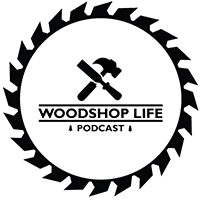Support us on Patreon: https://www.patreon.com/woodshoplife
Brians Questions:
Hi Friends: I really enjoy every podcast you guys put out. Thanks to Brain for stepping up to be the third host. He seems to be a natural with podcasting and teaching woodworking techniques. My question is related to tool choice. I am currently planning to build out a router table into the black phenolic extension table for my sawstop PCS 175. I have the 36inch cut capacity. I have seen videos on modifiying the extension table and dropping in a router lift. It seems like a great shop space saver. I have two questions for you guys. Do you think there is any value in having a stand alone router table? or is modifying the phenolic table a reasonable approach. I plan to build a custom fence to attach to the sawstop fence. My second question is – how important is it to buy a full size (3.25hp) router versus just getting a mid size router (2.25hp)? I currently have the milwaukee battery powered palm router (1.25hp) which has been useful but I want the accuracy and stability of a router table. The bulk of my work is edging and dados, but I would like the capacity to do raised panel cabinet doors and even to take my router out of the table and eventually build a flattening jig for large slabs. Is 2.25hp enough for these tasks? I am a hobbyist and don’t have any production needs for this setup but don’t want to be limited. Accuracy is important to me so I am going to go with a lift rather than buying a router with a base that can be screwed onto a table (like the triton). One issue is that a lift + router setup for a 2.25hp router is about $350 and for 3.25hp, I’m looking at $800+. Thaks in advance for your thoughts Sincerely, Jeremy Los Angeles, CA
ey guys I just wrote in and submitted a question but I do have another which I hope can be answered I’m building a kitchen table, 36×60” with a 1.5” top. The table is being made out of Rustic Rift Sawn White Oak Question is what is the best or a best method to ensure the top stays flat. This is in San Diego, Ca so weather/ humidity changes are the quite mild. I was thinking maple cleats across the bottom/ not glued but screwed allowing for movement. Any suggestions would be great Thanks and can’t wait for the next episode Nicholas
Guy’s Questions:
- What are the best responses to people who want you to make them something (usually for little or nothing)? [Most people are clueless regarding the effort and expense it takes to make something nice.] Have a great day Chuck
Hello all, the WoodMech here, I just purchased a ts55 festool tracksaw with the 55” guide rail for my kitchen remodeling project. I was wondering how accurate joining two tracks together compared to having the longer track? I was thinking about getting the guide rail with the shelf pin spacing holes and using that as the extension for cutting length wise on sheets of plywood. What are your thoughts or experiences? Thanks for the great show! Jeff Baran
Huy’s Questions:
Gentlemen and Guy 🙂 Have been listening for about a year and this is still the best woodworking podcast out there. I’d also like to thanks Sean for his contributions and welcome Brian to the show! My question is, there are so many woodworking content makers out there today. Who are the woodworkers that you guys follow ?? Second question… Assume you have become retired and now have lots of time on your hands. What woodworking projects would you work on? Would you go into production work and sell your goods, custom furniture??? What would be your ultimate retired woodworking project??? Thanks ! Liam Indianapolis, IN
So I’m having trouble with bubbles. Both when I’m using epoxy and fast drying/instant glue (Starbond) any advice on how to avoid them? I’m not doing large pours, this is simply some gap filling and knot hole stabilization. With the Starbond I do use their accelerator, but I’ve done it with and without, and it doesn’t seem to make a difference w/r/t the bubbles. Also, how do you get the glue/epoxy down into a pin hole? Mark Bett
